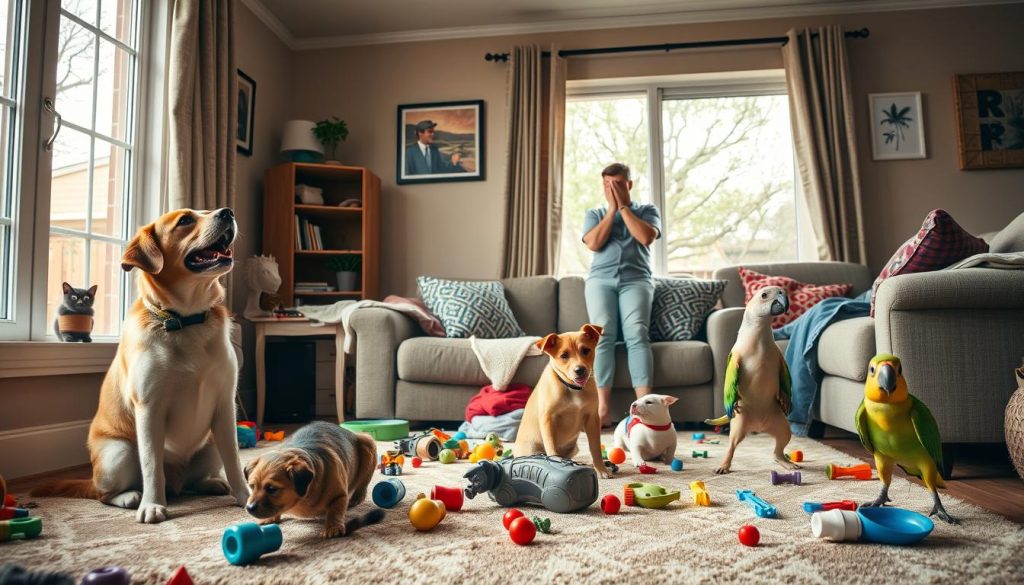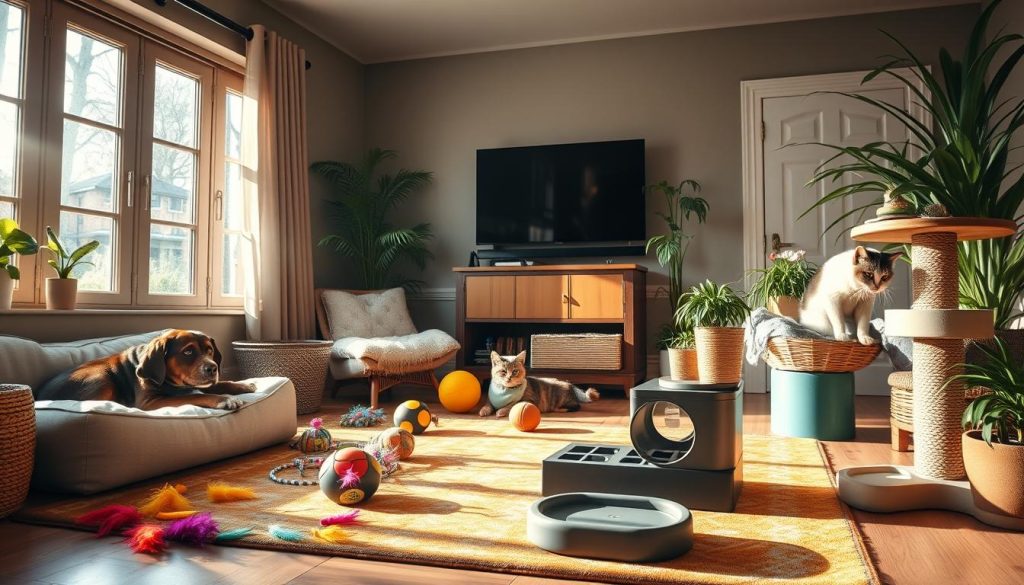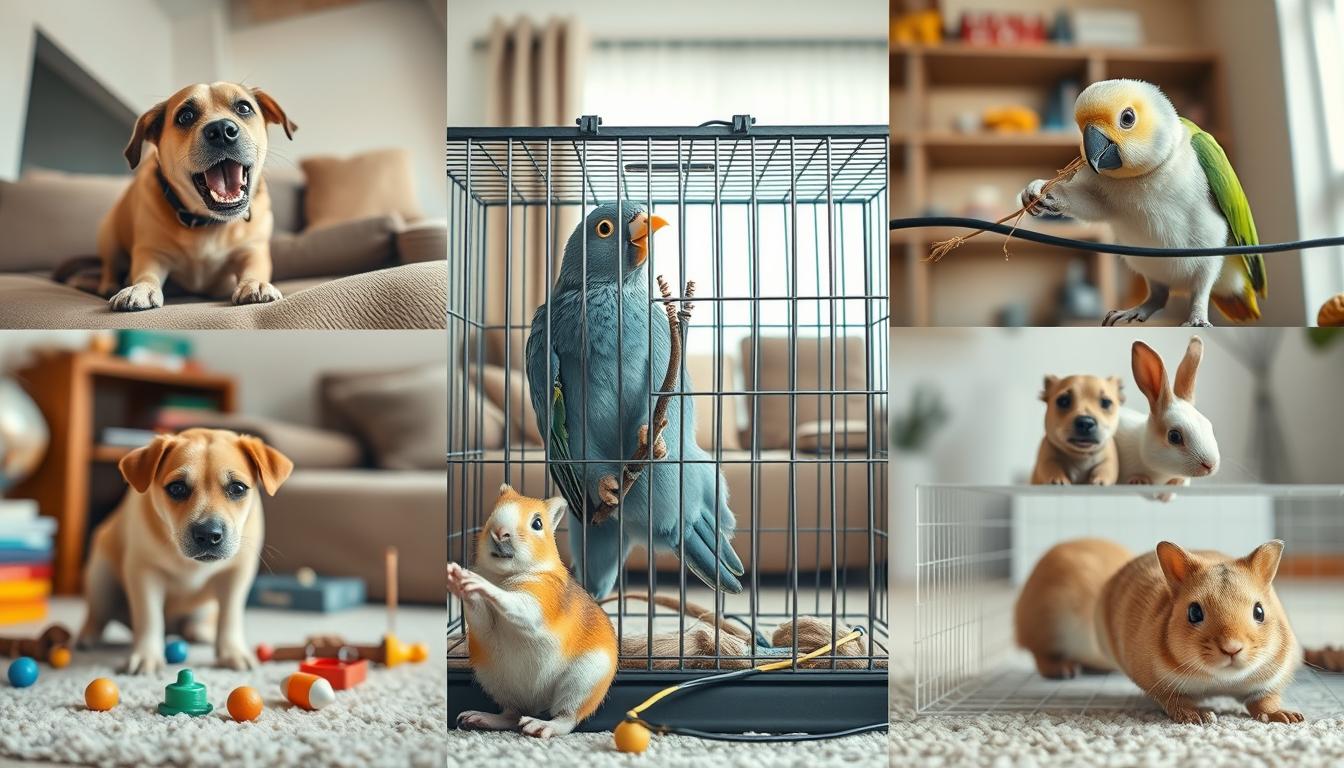Being a pet owner is full of joys and challenges. Whether you have a playful puppy or a curious cat, you’ve likely faced behavioral issues. But don’t worry, I’ve got expert advice to help you tackle these problems and strengthen your bond with your pet.
In this guide, you’ll learn how to manage common pet behavior problems and dog and cat behavior issues. You’ll also find ways to improve pet obedience. I’ll share tips on understanding your pet’s communication and mastering pet training techniques. This will help you create a happier home for you and your pet.
Dealing with a rambunctious puppy or a stubborn cat can be tough. But don’t worry, I’ve got the guidance you need. By the end of this article, you’ll know how to improve pet obedience and strengthen your bond with your furry friend.
Understanding Pet Behavior: A Crucial First Step
As a pet owner, understanding how your furry friend communicates is key. Learning to read their body language can give you insights into their needs and feelings. This helps you connect with them on a deeper level.
Decoding Canine Communication
Dogs communicate a lot without words. A wagging tail might not always mean they’re happy. It could also show they’re unsure or anxious. Watching your dog’s ear position, eye contact, and posture can help you understand them better.
Feline Body Language Demystified
Cats have their own way of talking, even if they seem aloof. A slow blink or a twitching tail can show a lot of emotions. Knowing these signs can help you and your cat get along better and solve problems early.
Exploring pet communication and psychology can make your bond stronger. It prepares you to handle common behavioral issues. With this knowledge, you’ll ensure your pet’s happiness and well-being.
Pet Behavioral Issues: Common Challenges and Solutions

As a pet owner, you might face many behavioral challenges. These can include too much barking, chewing, separation anxiety, and litter box problems. In this section, we’ll look at common pet behavior issues and offer solutions to solve them.
Dealing with Pet Aggression
Pet aggression can show up in many ways, like growling or biting. It’s a serious issue that might need professional help. To tackle it, find out what’s causing it, like fear or lack of socialization. Positive training and a safe space can help manage aggression.
Addressing Pet Anxiety and Fear
Things like separation, loud noises, or changes can make pets anxious. This can lead to bad behaviors like barking or soiling the house. To ease their anxiety, create a calm space, use calming products, and slowly introduce them to scary things.
Resolving House Training Problems
Accidents in the house can be upsetting. They might be due to bad training or health issues. Use positive training and give them chances to go outside to fix these problems.
| Common Dog Behavior Problems | Typical Cat Behavior Issues |
|---|---|
|
|
Understanding and solving these common pet problems can make your home happier. Remember, patience and consistency are crucial in fixing pet behavior issues.
Positive Reinforcement Training: A Gentle Approach

Positive reinforcement training is a great way to handle pet behavioral issues. It rewards good behavior instead of punishing bad ones. This method, like clicker training, helps you teach your pet gently. It also makes your bond stronger.
Reward-Based Techniques for Better Behavior
Clicker training is a favorite positive reinforcement method. It uses a small device that makes a click sound. When your pet does what you want, you give them a treat or praise right away.
This method is very effective. It clearly tells your pet what you want and gives them instant feedback. This helps them learn quickly.
- Clicker training helps pets learn new commands and behaviors quickly and easily.
- Reward-based techniques build trust and a strong emotional connection between you and your pet.
- Positive reinforcement training is a humane and effective way to modify unwanted behaviors.
Using positive reinforcement pet training can solve behavioral problems. It also makes your bond with your pet stronger. This approach is kind, compassionate, and works well.
Creating a Stress-Free Environment for Your Pet

Creating a stress-free home for your pet is key for their happiness and health. Simple changes can help reduce stress and anxiety in pets. This ensures they behave well and live a happy life with you.
Environmental enrichment is a big part of this. It means adding activities, toys, and things that meet your pet’s needs. Dogs might enjoy puzzle toys and play areas. Cats like scratching posts and toys that mimic hunting.
Making your home pet-friendly is also important. This means giving your pet places to dig or climb. It helps prevent bad behavior and keeps them happy.
It’s also vital to reduce stress and anxiety for your pet. This means keeping it quiet and providing cozy spots. Make sure they have familiar smells and objects for comfort.
By following these tips, you can make a happy, safe space for your pet. A happy pet is more likely to be well-behaved and enjoy life with you.
When to Seek Professional Help for Pet Behavior
While I try to offer helpful tips for pet behavior, sometimes you need a pro. If your pet’s behavior is persistent, disruptive, or worrying, it’s time to get help. A certified pet behaviorist or trainer can be your best ally.
Look out for signs like aggression, too much fear or anxiety, compulsive actions, and housetraining or obedience issues. Dogs might bark too much, pull on the leash, or get anxious when left alone. Cats might avoid the litter box, get aggressive, or scratch where they shouldn’t.
When choosing a professional, pick someone who uses positive methods and knows your pet’s issues. Stay away from those who suggest harsh methods. With the right help and consistent training, your pet can overcome their challenges and live happily with you.

